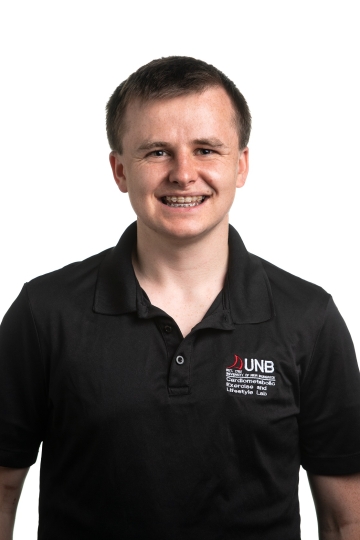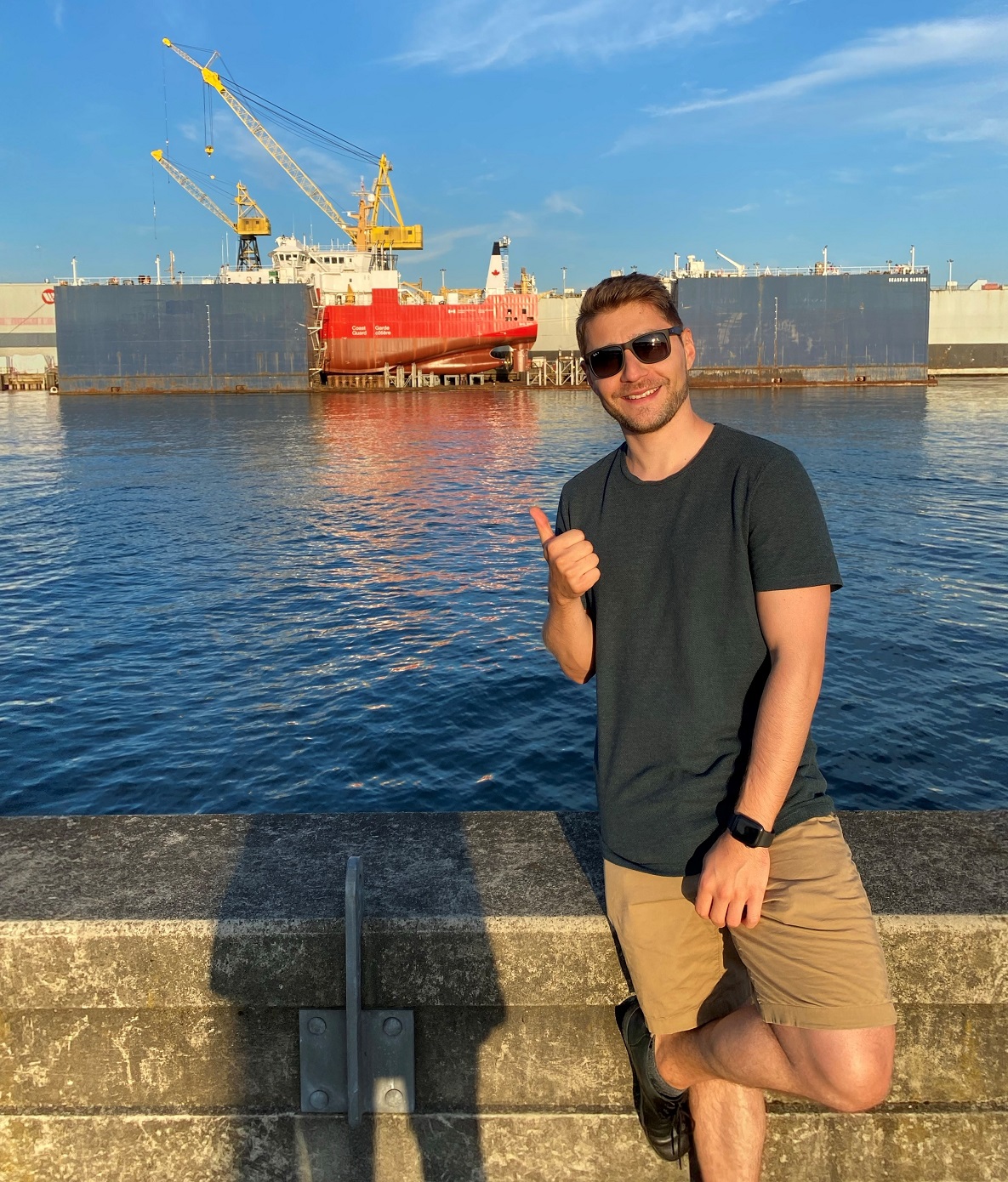
Erkan Cakir with the first Canadian Coast Guard Offshore Fisheries Science Vessel he worked on in the background.
Erkan Cakir
Mission Equipment Engineer
Seaspan Shipyards
Learn About My Career
I make sure the equipment and systems on the ships we build meet the needs and standards for the purpose they are designed to serve.
I was born/grew up in: I was born in Bulgaria but grew up in Turkey in a coastal city that is a two-hour drive away from the biggest city in the country, Istanbul.
I now live in: West Vancouver, BC
I completed my training/education at: I completed my undergraduate education at Istanbul Technical University, the best technical university in Turkey (it was established in 1773). During my undergrad degree I completed a full year of an exchange program in Germany at the Technical University of Hamburg. After returning from Germany, I wanted to try somewhere different and decided to pursue my higher education in Canada. I obtained my master’s degree from the research-based Ocean and Naval Architectural Engineering (ONAE) program at Memorial University in St. John’s, Newfoundland. ONAE offers the only co-operative ocean and naval architectural engineering program in the world.<
I work as part of a team that designs and builds ships for the Royal Canadian Navy and the Canadian Coast Guard. Each ship is built for a specific purpose. My role is to make sure the equipment and systems on these ships is what they need. This helps make sure the ships we produce will be able to do what they are intended to do.
I make sure that my team’s activities are completed on time. To do this, I have to coordinate with different departments. I do this using email, Microsoft Teams and in-person meetings. I use my ship building knowledge while tackling issues regarding the design and integration of mission equipment. Since we are building ships, spatial integration skills are important in addition to mechanical technical knowledge. We use 3D modelling software to model and review drawings and 3D design. I also use the Microsoft Office 365 suite (for example, Word, Excel and Outlook) to help deliver my work.
The problems I need to solve are mostly related to equipment design, integration and project management. When I need to make an engineering decision, I follow a set process. I first consider the Ship Specification. This includes a description of what the ship will be used for, where it will be used, etc. We get this information from our client (i.e., the Royal Canadian Navy or Canadian Coast Guard). Then, I determine if the problem is related to the systems for which I am responsible. If it is, I find the source of the problem. If necessary, I will contact our suppliers if the problem is on their end. If the problem also impacts other departments, I’ll bring them into the discussion.
My background in STEM helps me to easily analyze problem and provide solutions in complicated systems. It also helps me weigh the pros and cons of each solution so that I can determine the best way forward. As I said above, my work requires a high level of coordination and cooperation with other team members. As a result, being a good cooperative team member is important. Our communication and the language of the technical documents is English.
I couldn’t imagine that I’d be doing what I’m doing today when I was in high school. I graduated from a special high school in Turkey that focuses on educating teachers. Both of my parents are teachers. I thought that might be the path for me too. But I realized that I wanted to be involved in applied science. I always had a knack for solving problems and designing “do it yourself” custom toys for myself. Planes and ships always intrigued me. When it was time to pick one of them in university, I went with ships.
I had to get an engineering degree to be able to practice my profession. I had three co-op placements in three different shipyards in my home country, Turkey. When I needed to advance in my education and experience, I always tried to go out of my comfort zone. I believe growth always lies outside of where you are comfortable.
The thing that gets me the most excited is to see the vessels we have built out on the ocean doing their work. There is nothing like launching a vessel after all the hard work you put in and seeing it serving its crew. I get to see a lot of different equipment that is designed for different missions. Their design philosophy is always of interest me.
Due to the nature of my work I get to work with many different people. I find it very interesting to see different styles of communication and problem-solving.
I enjoy dealing with challenges that require teamwork and technical expertise. The reward of doing something unique in Canada that serves the public through the Canadian Coast Guard and the Navy make this the right career for me.
We build ships for the Canadian Coast Guard. These ships will be used to conduct scientific research that aims to understand the impacts of global warming on our oceans. These ships are also used in search and recovery missions. Knowing that the vessels we build are helping people at sea is a great feeling. It is also very fulfilling to know that these ships will carry the people who will help develop a better understanding of ways to reduce the impacts of global warming. Mission equipment and systems are key to the way the vessels operate. These are the things that allow the Canadian Coast Guard and Royal Canadian Navy conduct their missions in our oceans. Without mission equipment these vessels wouldn’t be any different than a cruise ship.
I like skiing with friends, biking and playing the guitar. I used to play the guitar professionally and compose music. I am currently trying to find a band to perform with in Vancouver.
Engineering is a very rewarding career. It does require a significant amount of dedication and time. I would recommend that everyone should really try to find their true passion and follow it, even if it lies outside of their comfort zone. At the end of the day, skills are way easier to learn in something you are passionate about, compared to trying to learn doing something you are not passionate about.
What I do at work
I work as part of a team that designs and builds ships for the Royal Canadian Navy and the Canadian Coast Guard. Each ship is built for a specific purpose. My role is to make sure the equipment and systems on these ships is what they need. This helps make sure the ships we produce will be able to do what they are intended to do.
I make sure that my team’s activities are completed on time. To do this, I have to coordinate with different departments. I do this using email, Microsoft Teams and in-person meetings. I use my ship building knowledge while tackling issues regarding the design and integration of mission equipment. Since we are building ships, spatial integration skills are important in addition to mechanical technical knowledge. We use 3D modelling software to model and review drawings and 3D design. I also use the Microsoft Office 365 suite (for example, Word, Excel and Outlook) to help deliver my work.
The problems I need to solve are mostly related to equipment design, integration and project management. When I need to make an engineering decision, I follow a set process. I first consider the Ship Specification. This includes a description of what the ship will be used for, where it will be used, etc. We get this information from our client (i.e., the Royal Canadian Navy or Canadian Coast Guard). Then, I determine if the problem is related to the systems for which I am responsible. If it is, I find the source of the problem. If necessary, I will contact our suppliers if the problem is on their end. If the problem also impacts other departments, I’ll bring them into the discussion.
My background in STEM helps me to easily analyze problem and provide solutions in complicated systems. It also helps me weigh the pros and cons of each solution so that I can determine the best way forward. As I said above, my work requires a high level of coordination and cooperation with other team members. As a result, being a good cooperative team member is important. Our communication and the language of the technical documents is English.
My career path is
I couldn’t imagine that I’d be doing what I’m doing today when I was in high school. I graduated from a special high school in Turkey that focuses on educating teachers. Both of my parents are teachers. I thought that might be the path for me too. But I realized that I wanted to be involved in applied science. I always had a knack for solving problems and designing “do it yourself” custom toys for myself. Planes and ships always intrigued me. When it was time to pick one of them in university, I went with ships.
I had to get an engineering degree to be able to practice my profession. I had three co-op placements in three different shipyards in my home country, Turkey. When I needed to advance in my education and experience, I always tried to go out of my comfort zone. I believe growth always lies outside of where you are comfortable.
I am motivated by
The thing that gets me the most excited is to see the vessels we have built out on the ocean doing their work. There is nothing like launching a vessel after all the hard work you put in and seeing it serving its crew. I get to see a lot of different equipment that is designed for different missions. Their design philosophy is always of interest me.
Due to the nature of my work I get to work with many different people. I find it very interesting to see different styles of communication and problem-solving.
I enjoy dealing with challenges that require teamwork and technical expertise. The reward of doing something unique in Canada that serves the public through the Canadian Coast Guard and the Navy make this the right career for me.
How I affect peoples’ lives
We build ships for the Canadian Coast Guard. These ships will be used to conduct scientific research that aims to understand the impacts of global warming on our oceans. These ships are also used in search and recovery missions. Knowing that the vessels we build are helping people at sea is a great feeling. It is also very fulfilling to know that these ships will carry the people who will help develop a better understanding of ways to reduce the impacts of global warming. Mission equipment and systems are key to the way the vessels operate. These are the things that allow the Canadian Coast Guard and Royal Canadian Navy conduct their missions in our oceans. Without mission equipment these vessels wouldn’t be any different than a cruise ship.
Outside of work I
I like skiing with friends, biking and playing the guitar. I used to play the guitar professionally and compose music. I am currently trying to find a band to perform with in Vancouver.
My advice to others
Engineering is a very rewarding career. It does require a significant amount of dedication and time. I would recommend that everyone should really try to find their true passion and follow it, even if it lies outside of their comfort zone. At the end of the day, skills are way easier to learn in something you are passionate about, compared to trying to learn doing something you are not passionate about.
When I was a student I enjoyed:
- Art
- Drama
- Foreign Languages
- Math
- Music
- Science
- Technology
When I was a student, I would describe myself as someone who:
- Brought people together
- Enjoyed doing things on my own
- Organized activities for my friends
- Was motivated by success
- Wanted to be in charge
- Engaged in volunteer activities
- Was really creative
- Felt great satisfaction in getting good grades
- Learned best “by doing”
- Liked to design or build things
- Liked to take things apart to see how they worked
Partners
Seaspan Shipyards
Let’s Talk Science appreciates the support of Seaspan Shipyards in connecting us with this individual.
Seaspan Shipyards is a leader in Canada’s shipbuilding and ship repair industry. With modern facilities and a dedicated workforce of 2,700 in North Vancouver and Victoria, Seaspan Shipyards has proven itself to be a trusted partner on a range of complex projects for both government and the private sector. Seaspan Shipyards is proud to be Canada’s chosen non-combat shipbuilder under the National Shipbuilding Strategy (NSS). In this capacity, the company is building state-of-the-art ships in Canada for the Canadian Coast Guard and Royal Canadian Navy. Through its NSS-related work, Seaspan Shipyards is creating jobs, generating economic benefits and rebuilding Canada’s shipbuilding and marine industries.
Related Topics
Explore More Career Profiles
-
Brianna Lummerding
Career Profiles
Agronomic Innovation Manager
I look after all things related to soil management for a group of retailers. -
Li Tan (he/him)
Career Profiles
Molecular Lead
I coordinate the day-to-day operations in the DNA Extraction Lab. -
Tyler Morhart (video)
Career Profiles
Scientist, Beamline Responsible - SyLMAND
I am responsible for the SyLMAND beamline at the Canadian Light Source synchrotron facility. -
Li Tan (Video)
Career Profiles
Molecular Lead
I coordinate the day-to-day operations in the DNA Extraction Lab. -
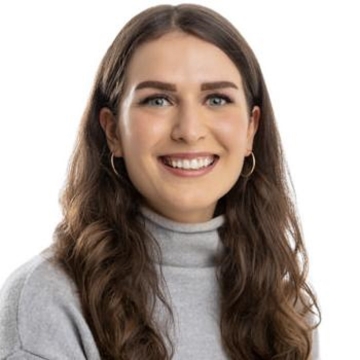
Rashell Featherstone (she/her)
Career Profiles
Senior Program Associate
I coordinate projects for the development of new products at STEMCELL. -
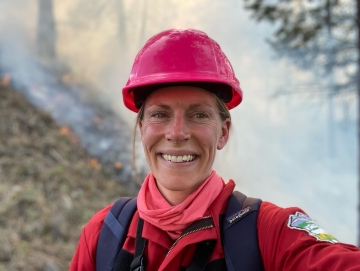
Kira Hoffman (she/her)
Career Profiles
Postdoctoral Researcher/Fire Ecologist
I am a researcher at both a university and a not-for profit organization where I am gaining experience to become a senior researcher. -
Zoë Ehlert (Video)
Career Profiles
Manager, Marker Assisted Breeding
I lead a team that develops canola crops by breeding plants with traits we are looking for. -
Zoë Ehlert
Career Profiles
Manager, Marker Assisted Breeding
I lead a team that develops canola crops by breeding plants with traits we are looking for. -
Jennifer Baltzer (she/her)
Career Profiles
Professor and Canada Research Chair in Forests and Global Change
I work at a university, teaching students and conducting research on the impact of climate change on forests in Canada and around the world. -
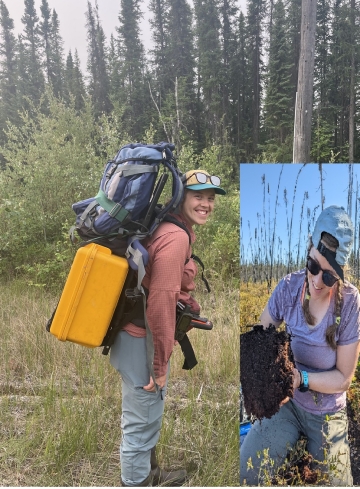
Caitlyn Lyons (she/her)
Career Profiles
Ph.D. Candidate
I am working towards my PhD and studying the forests in the Northwest Territories. -
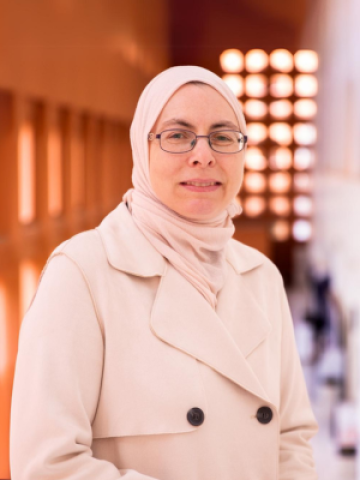
Joann Whalen
Career Profiles
Professor at the Faculty of Agricultural and Environmental Sciences,
I teach advanced courses on how to manage soils to produce healthy, nutritious food and maintain healthy ecosystem functions.
